Moment Brew
Smartphone-based AR for capturing and sharing special coffee moments.
What we did
What makes a moment special? Moment Brew is a mobile augmented reality product that allows users to visually express and capture their thoughts, feelings, and context of their unique coffee-accompanied moments and share them with others. It also opens up new possibilities for enhanced social interaction, as it allows users to draw on the same 3D world - both synchronously and asynchronously - even when they are physically apart from each other.
For this project, my main contributions were designing features and implementing
partially functional mobile Augmented Reality application using Vuforia and Unity.
I also took parts in brainstorm, ideation, conducting user research (social media data
scraping and analysis),
usability testings, crafting prototypes, and designing the poster.
Background.
What makes a (drinking coffee) moment special?
People go to coffee shops for various reasons, and their experiences with coffee are often unique, whether it is solitarily enjoying coffee, studying with classmates, listening to ambient music, reading a book, visiting a new place, or trying new special drinks. There are hundreds or thousands of coffee-accompanied activities that they can do, but how can we help them capture or co-capture their coffee drinking experiences in a more fun and meaningful way.
Through our capstone project, we sought to explore how we can help people capture and share special and memorable moments more effectively. Specifically focusing on coffee-drinking activity which contains a lot of potential ingredients of a unique/memorable moment, we implemented an extensive human-centered design process throughout the 10-week period to create a design solution that can enhance people’s everyday experience of capturing and communicating their cherished memories to others.
Process.

Research.
We conducted a multi-methodology research effort to better understand how people define their “unique moments”, how they wish to capture them, their coffee-drinking experience & current use of technology, and how academic researchers have sought to explore these questions in their relative fields of study.
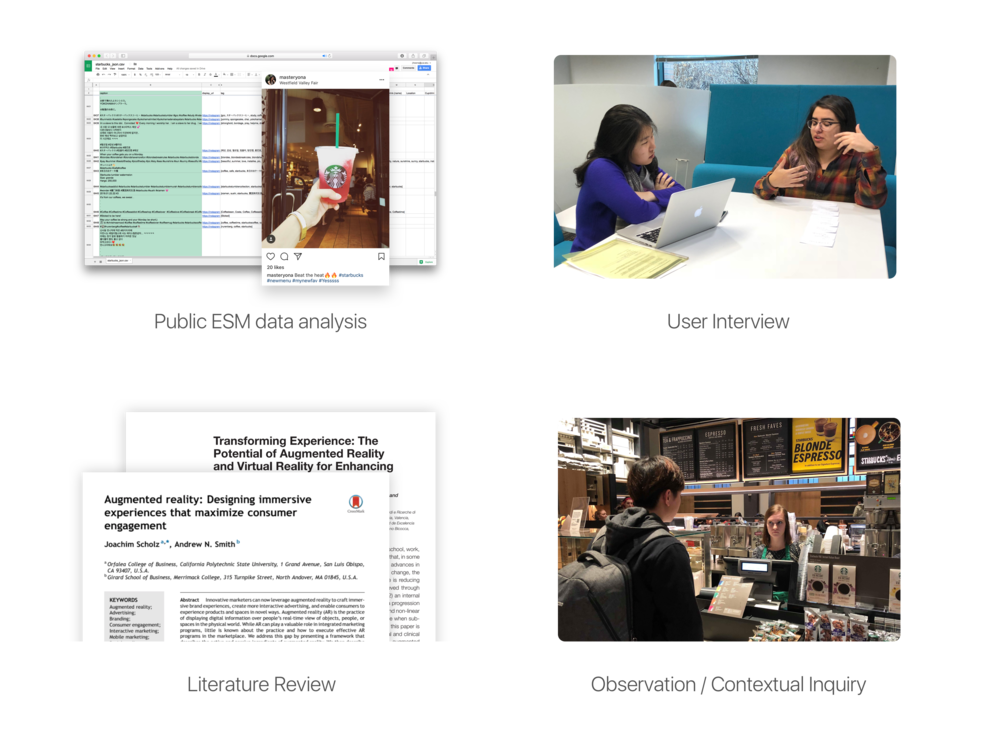
What makes moment special?
A uniqueness of moment motivate people to capture and share them with others. With this card-sorting exercise we wanted to know what ingredients compose a unique/special moment. This was an important interview question, because it helps us understand what components are prioritized over the others in a given moment. We wanted to see if coffee-accompanied experience had different priorities of ingredients. Emotion/feeling and people were ranked the highest in both general and coffee-drinking context.

We saw a hierarchy emerging in the participants’ responses: the seemingly separate components turned out to be codependent and ranked in different levels of influence. At the top, emotion/feeling positions itself as the bigger umbrella that’s influenced by other components. Similarly, there were some lateral and pseudo-influencing relationships. For example, weather is influenced by location/time. Activity and people can be related, since a meeting usually takes place when two or more people gather.
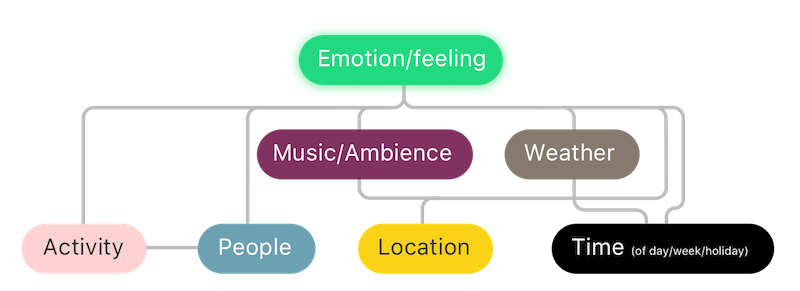
How do people capture and share their coffee-accompanied moments currently?
In order to understand people's current behavior in sharing and capturing coffee moments, we analyzed public ESM data from public Instagram posts containing “#starbucks.” We chose Starbucks because it is one of the largest coffee chains, and we speculated it would have a big social media presence. We utilized a Python script to scrape about 9500+ public posts, then and conducted a manual categorical analysis on randomly chosen 3000 posts.

Extract Insights
Based on our research data, we analyzed and extracted recurring themes and patterns across research activities into 5 insights.
Ideation.
Affinity Diagram
To start out the ideation phase, we conducted an affinity diagramming exercise as a team to examine emerging patterns and groupings of objects, materials, and activities around coffee-drinking and moment-capturing.
Based on the affinity diagrams and our previous research insights, we realized that the ideas around moment-capturing in the context of coffee drinking differ by the intents of capture and the objects of capture. We clustered them into the following three different user scenarios.
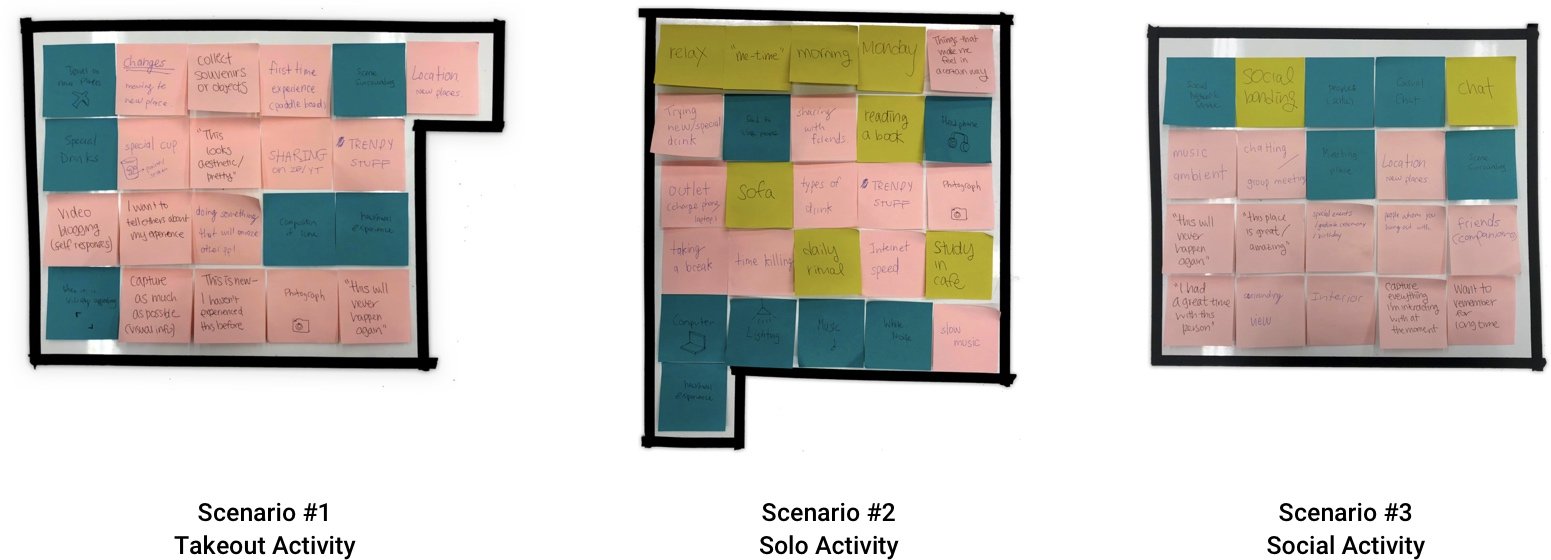
These 3 user scenarios we have can be visualized as the user flow below. As this flow shows, the unique moments in coffee drinking can occur once the user picks up the drink.
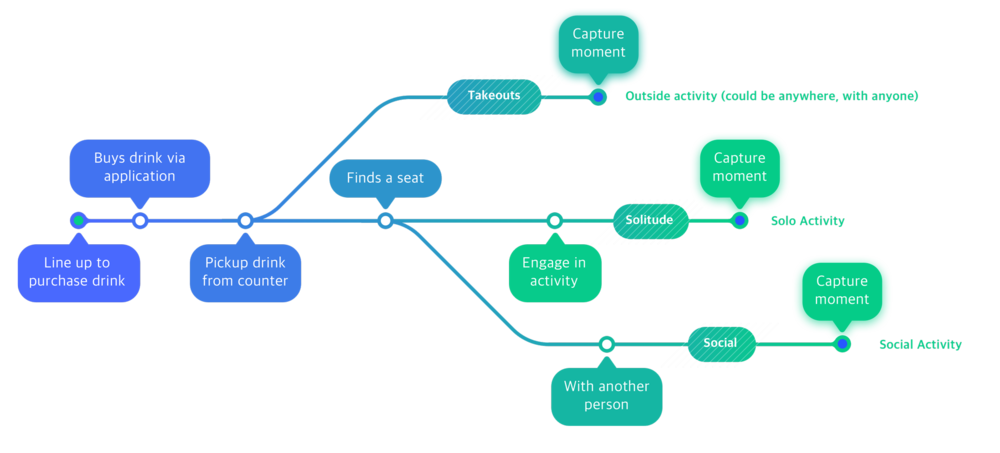
Brainstorm & Sketch.
Using the three insight-driven user scenarios, we conducted a series of sketching sessions to brainstorm and come up with possible features and methods that could potentially improve the current ways of moment-capturing in the context of coffee-drinking. The ideas spun around at different stages within the three user scenarios we have. While some focused on providing fun ways of moment-capturing, some ideas revolved around setting a unique moment such as social planning and coffee recommendation.
Concept Refinement
We conducted short semi-structured interviews and design evaluation regarding the sketches / storyboards to evaluate what design concepts can best capture people’s need and best suit with the purposes of the product. From 4 participants we learned their subjective feedback on how these individuals viewed and evaluated our concepts, which helped us scope down ideas from many to few.

Participants like my idea, Moment Brew, this feature allows users to add 2D freeform drawings in a 3D world. It enables users to express and capture their thoughts, feelings, and experience in a visual way. It can also help them experience their special moments in a more meaningful and creative fashion. It also opens up possibilities for enhanced social interaction, since users could also simultaneously draw on the same 3D world even when they’re physically far away. They could also save these illustrations based on geographical location or fixed anchor point (e.g. unique marker on an object), and share to others who would encounter the same location/object in the future. .

Design.
Moment Brew Scenarios

Initial wireframe
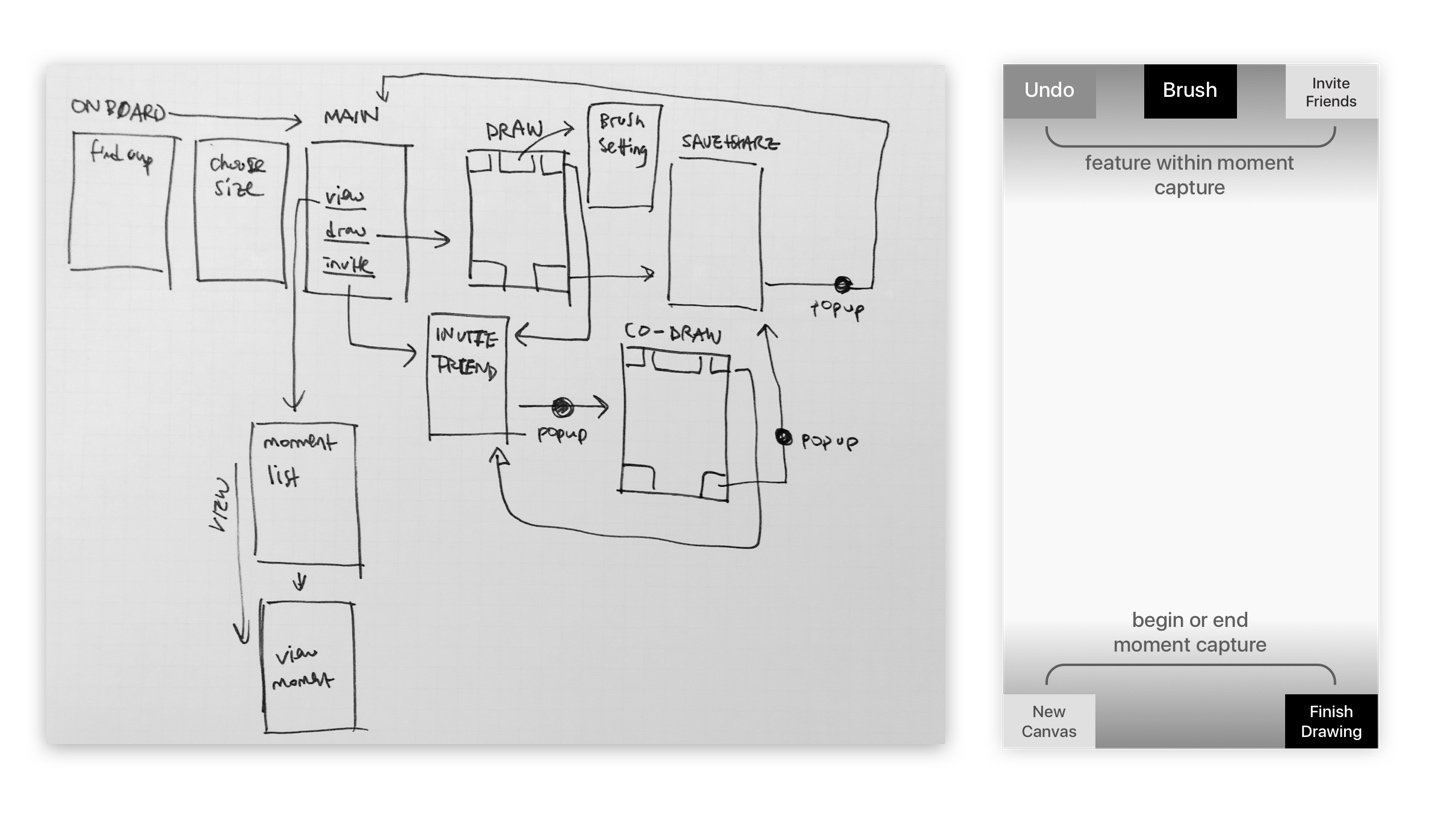
Paper prototype
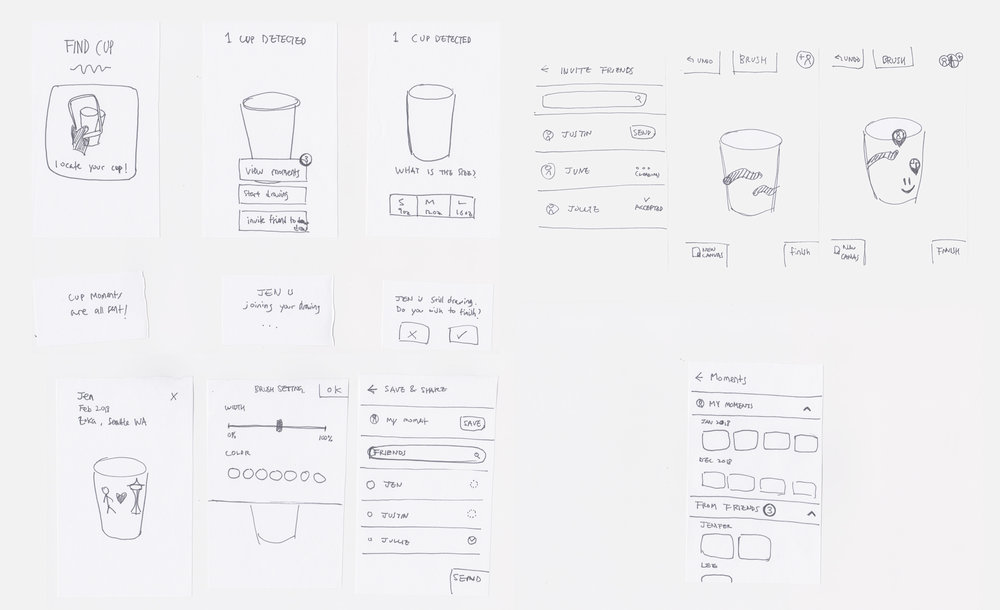
Interaction map
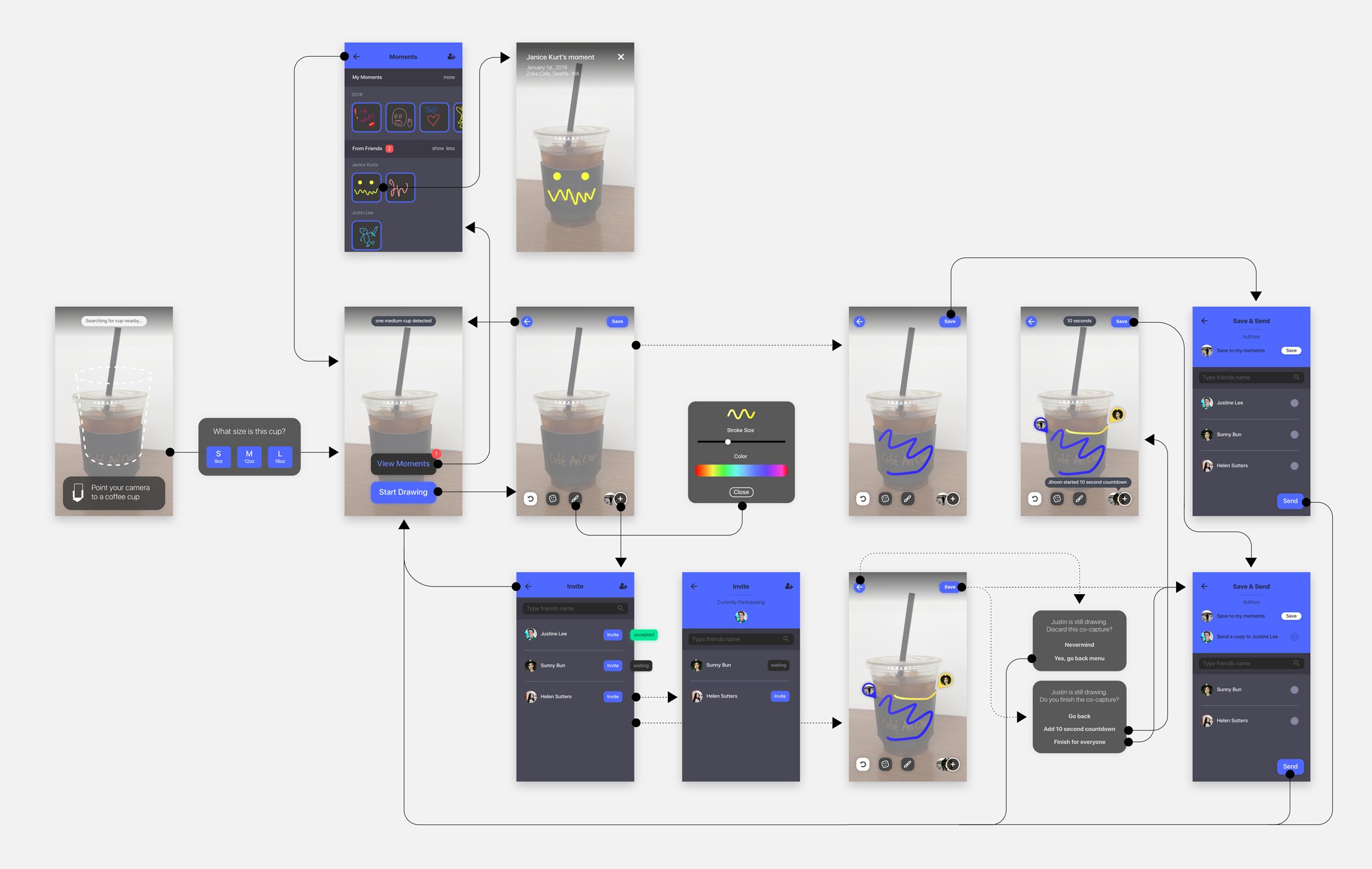
UI Design
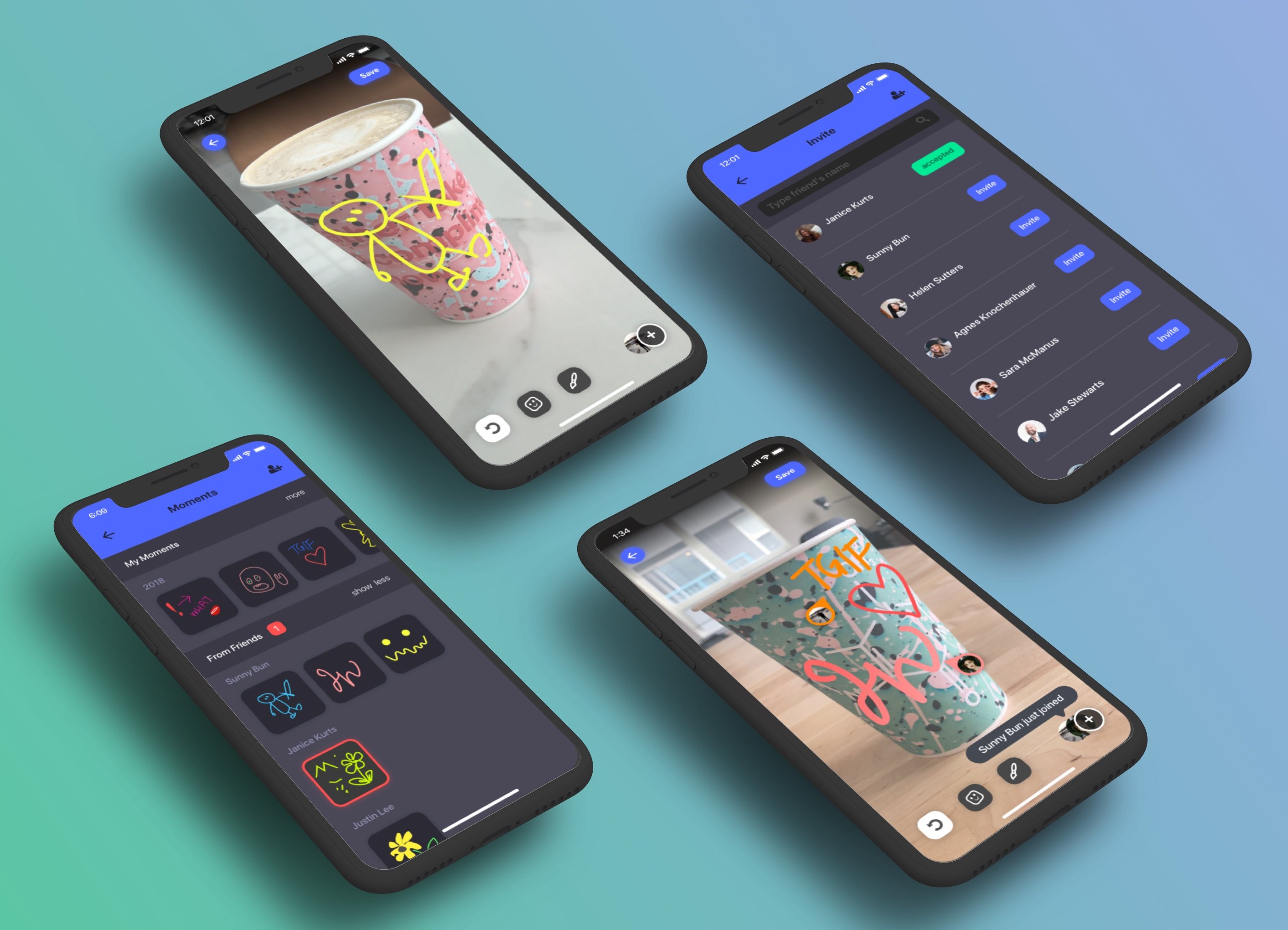
Design Iteration.
Usability Studies
For the evaluation phase, we utilized task-oriented usability testing method and Concurrent Think-Aloud (CTA) Protocol1 to gather real-time feedback on our concept and prototype from the target user base. We wanted to start out by testing the paper prototype first with a couple participants, then based on the feedback iterate on the digital prototype with few more participants. Our target users are people who:
- Are young adults and/or adults
- Have previous experience with smartphone and its camera technology
- Buy coffee from cafes and coffee shops on a regular basis
- Use social media platform(s) on a regular basis
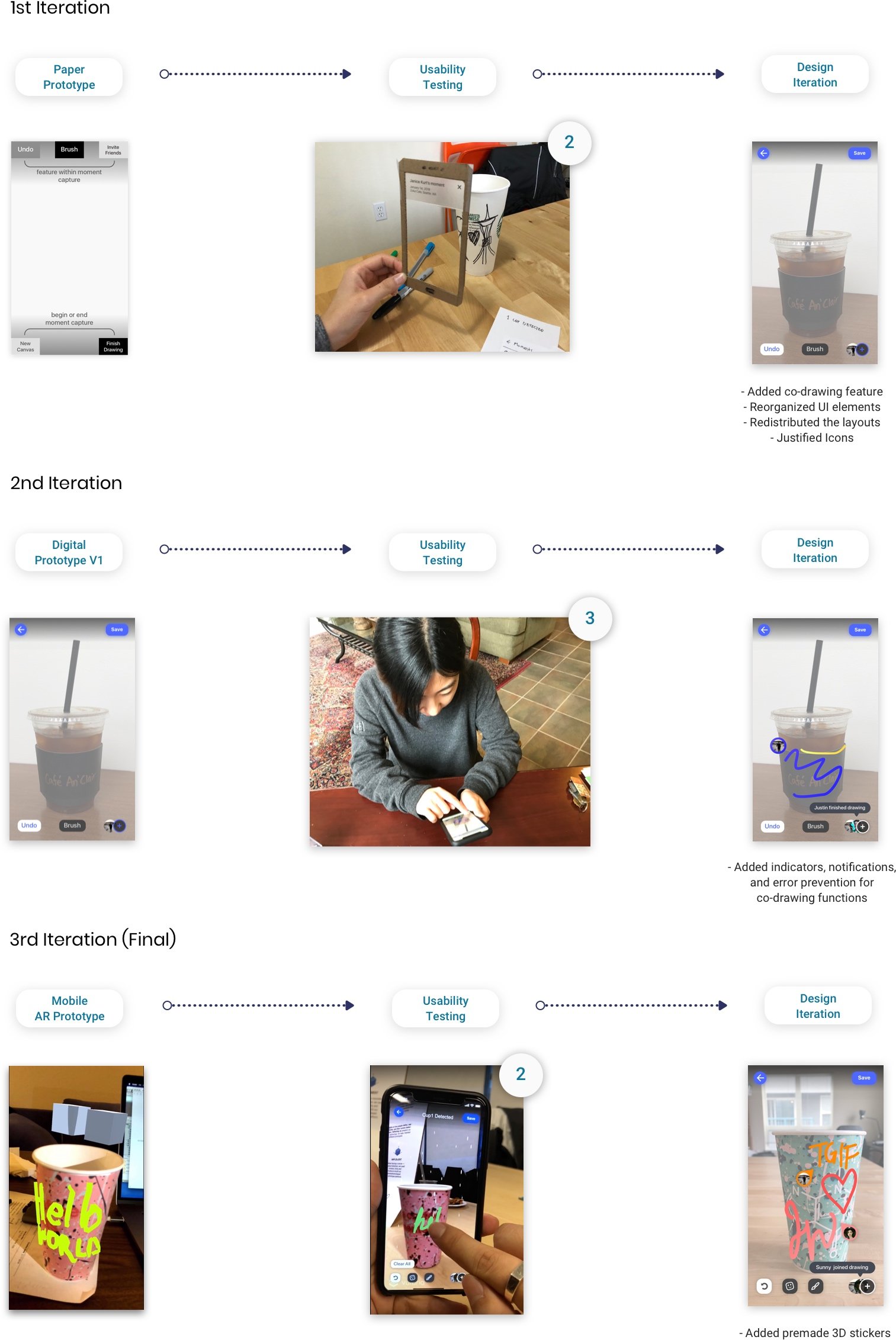
Final design.
Core functions
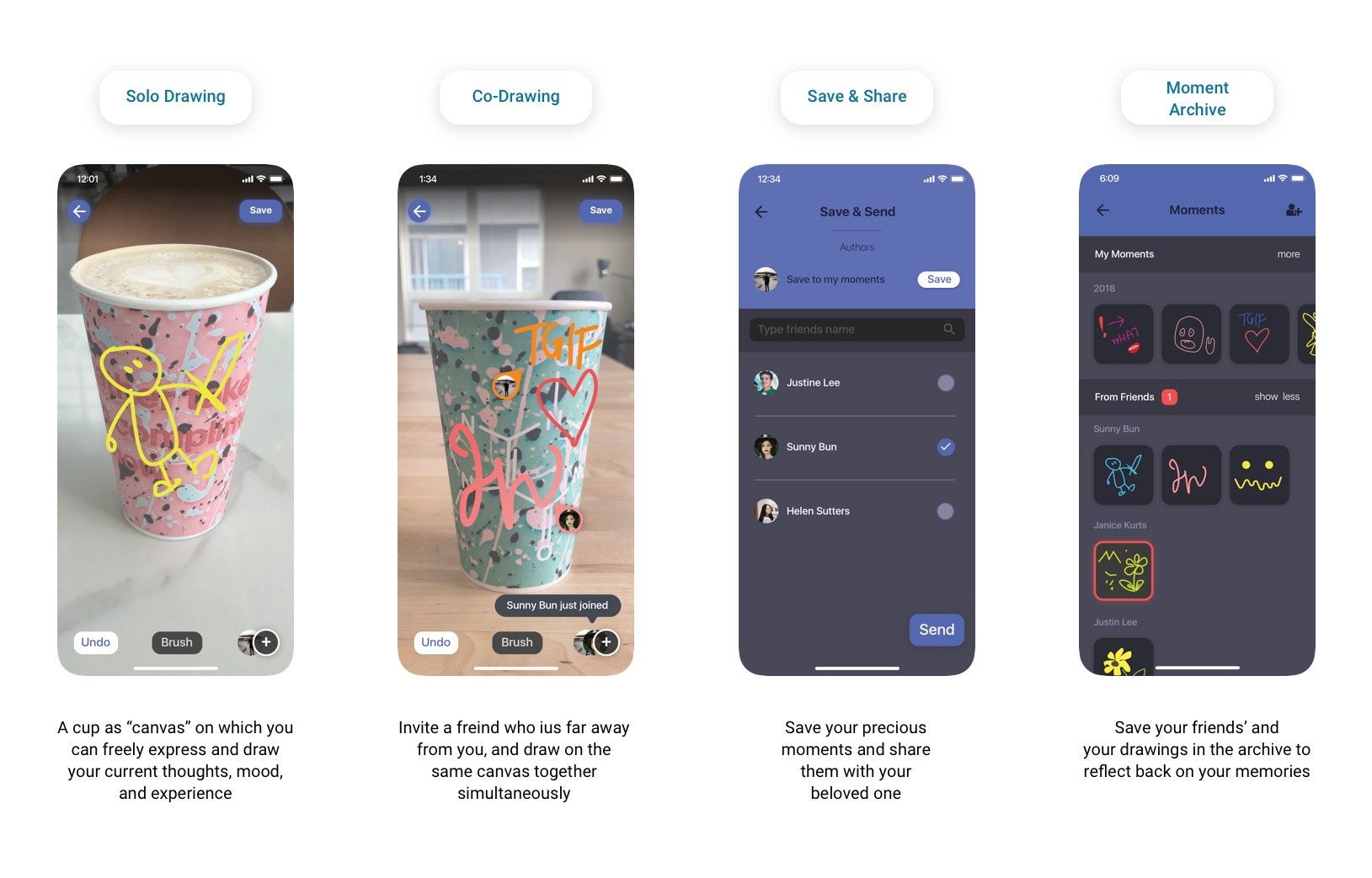
Core drawing features
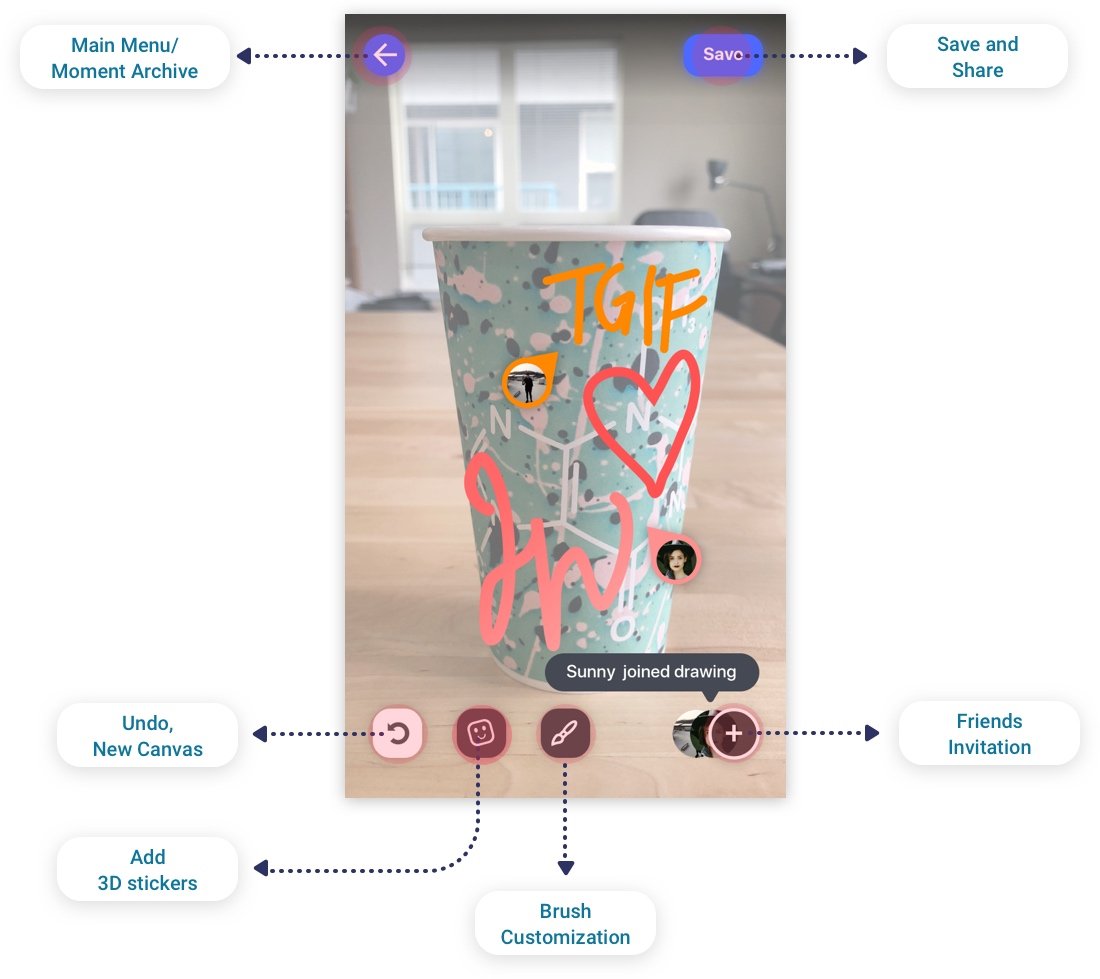
Implementation.
After having a concrete design direction and final prototype, we took another step forward into the implementation process. We have done research on AR development to find optimal solutions, softwares, and SDK that best suit our application. At the end, we decided to use Vuforia platform and Unity game engine to build our partially functional mobile Augmented Reality application. The main reason for choosing these two technologies was because Vuforia has Image Target feature that can recognize and track objects by analyzing the contrast based features of the target that are visible to camera. So, it can enable us to detect the cup based on a unique pattern that we designed and used on the cup sleeve.

Implementation Process
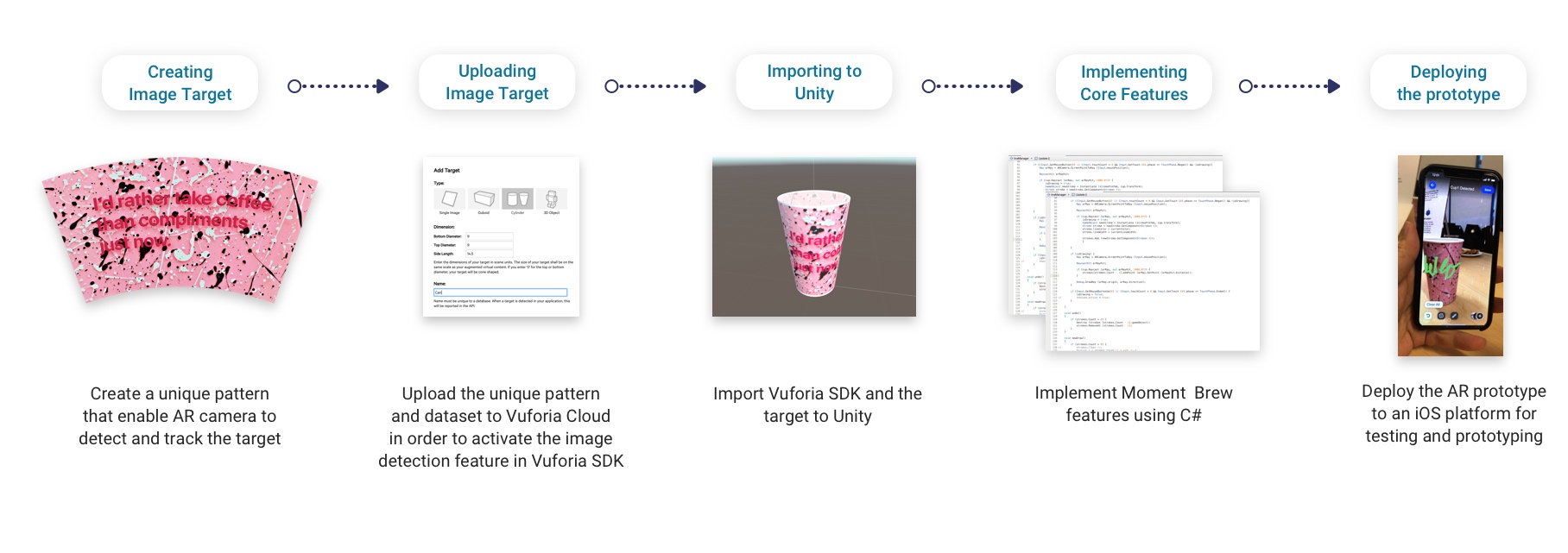
How it works
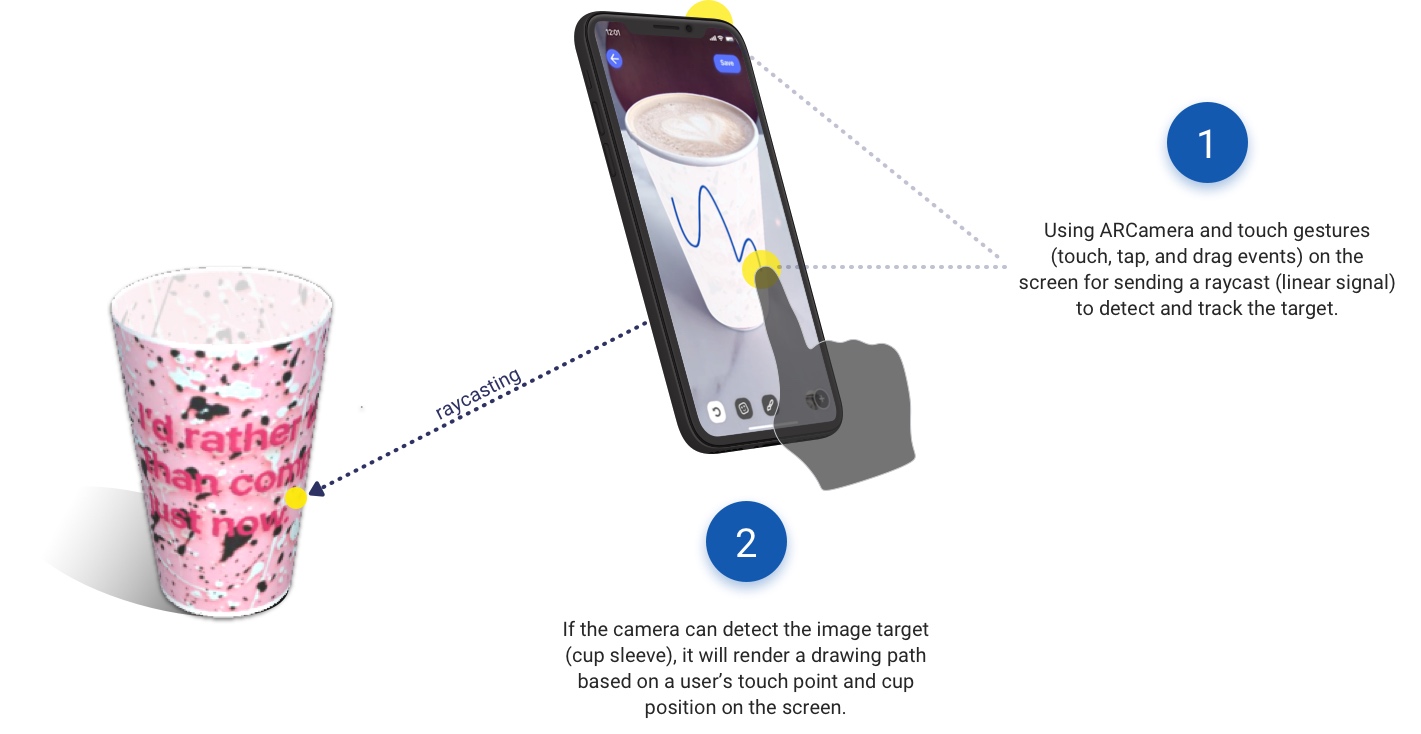
How to create a canvas
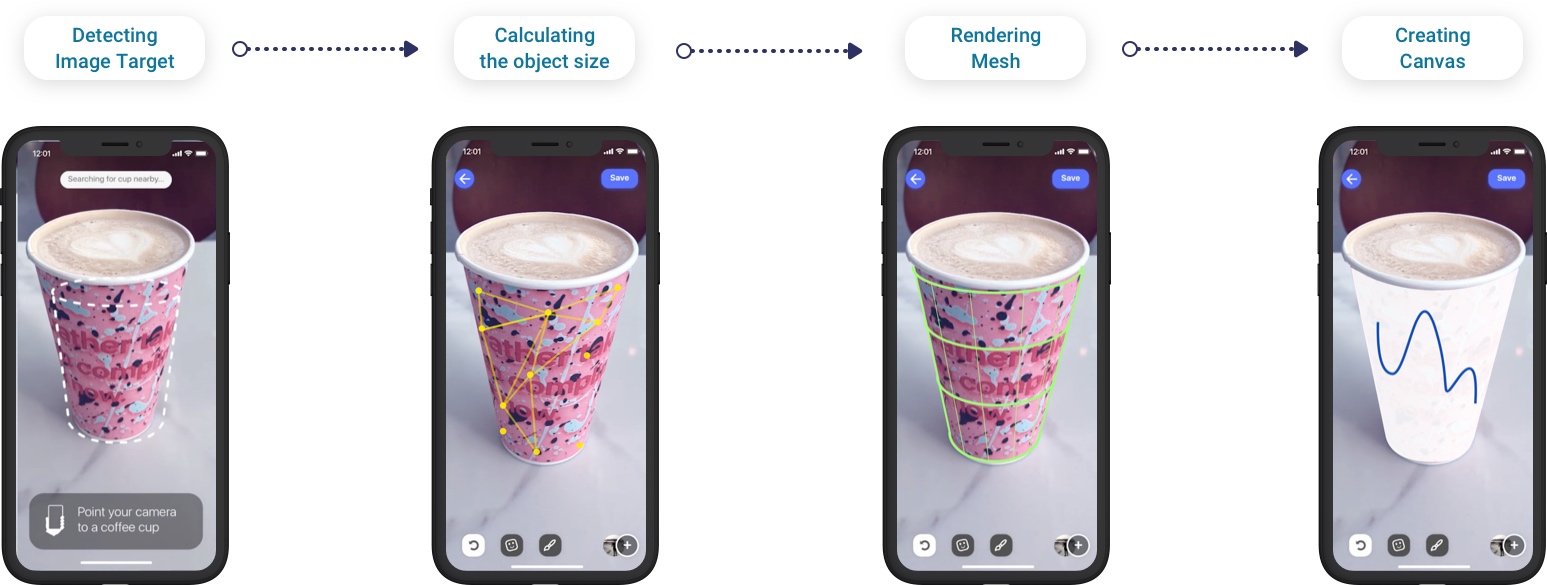
Final Deliverable.
Reflection.
It gave me an opportunity to explore the novel technology, namely augmented reality, in human-centric approaches and perspectives. We were able to learn and expand the usage and application of Augmented Reality into something more user-centered, as opposed to the current trend that heavily focuses on gaming and entertainment.
The most important growth points that I gained from this project were that I were able take parts in research, design, and build a successfully working prototype starting from the absence of good previous data points or lots of academic research to base off of.
Limitation & Concern
-
Technical Feasibility
We decided to implement just only solo drawing feature because we didn’t have enough resources (e.g. time and incentive) to implement and deploy other two features, collaborative drawings and moment archive. Those features need web server and real-time communication server. -
Social Interaction
We do understand that too much smartphone usage in outdoors setting can make people feel more disconnected and/or isolated from real world. Moment Brew can alleviate this problem by connecting distant friends into sharing and co-capturing moments. -
Privacy
Primary concerns on Moment Brew can arise from unsolicited use of camera and microphone for mobile phone users. This is a common issue that all smartphone-based AR application face. We believe that Moment Brew onboarding experience should provide assurance and level of security that users desire when the app requests access to the camera, microphone, and/or location data.
Next Step
- Implement improvements and additional features based on user feedback
- Explore directions to use this technology in commercial coffee market
- Explore directions to use this technology in other fields (non-coffee)












